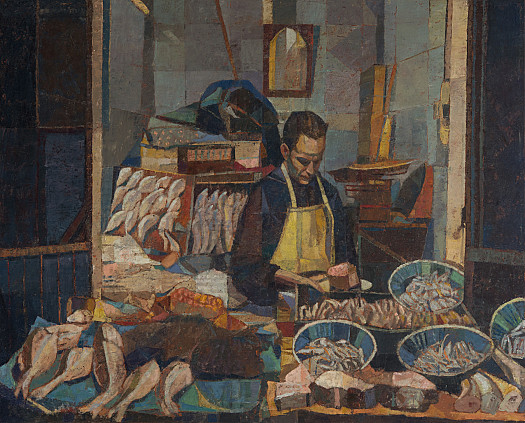.
Saied’s approach is fundamentally psychological. All the formal elements of language are at the service of articulating and realising this, through the use of geometry and construction – as a form of underlying architecture. His love of geometry and pattern was, he suggests, possibly imbibed from his Persian philosophical heritage, as also perhaps were his reticence and equable temperament. Balance and equilibrium are of paramount importance in his work, in creating stillness and silence, qualities he values and deems more profound.
He believes that art engenders the awareness and appreciation of beauty and, even more strongly, that the study of art is the study of life.
Saied Dai was born in Tehran on 8 April 1958 into a family of scholars and doctors. When he was six years old, he and his younger sister, Navid, were sent by their parents to England, but their parents did not follow them. Instead, they were placed with foster parents and attended a number of boarding schools, including, most notably, The Licensed Victuallers School, Slough (1967-76). As a school student, Saied excelled at sciences and was offered places at two medical schools, but decided instead to pursue an artistic path.
Saied attended Bournemouth & Poole College of Art and Design for four years, and during that time gained both a Foundation Diploma and a degree in Fine Art. Graduating to the Royal Academy Schools, London, he studied under Roderic Barrett (who influenced his approach to composition), Norman Blamey (who recognised his talent for drawing) and Peter Greenham. While there, he pursued extra-curricular instruction at the Wellcome Museum of Anatomy and Pathology at the Royal College of Surgeons, as well taking classes in anatomy, chemistry and perspective. He also chose to spend time copying works by Velasquez and Vermeer in the National Gallery. In addition, he studied with Cecil Collins at both the City Lit and the Central School of Art and Design. Collins’s classes provided an opportunity to explore the creative process, and so complemented his established practice of analytical drawing. In 1988, he painted a portrait of Cecil Collins.
Continuing to live in London through the 1990s, Saied gradually began to establish his reputation by contributing to mixed exhibitions, including the Royal Academy Summer Exhibition (from 1994). He helped support himself through part-time teaching at a number of institutions, including the RA Schools; The Prince of Wales School of Architecture, Regent’s Park; Kingston School of Art; Christ Church College, Canterbury; and Bournemouth & Poole College; and also worked for the NSEAD programme of teaching teachers, which took him to Glasgow School of Art and Kingston School of Art.
Said met his future wife and fellow painter, Charlotte Sorapure in 1987. When she graduated from Cheltenham to the RA Schools in 1992, she joined him in London. In 2002, they married in Bath, Somerset, and settled in Upper Swainswick, to the north of the city.
Since the year 2000, Saied has been a regular exhibitor with the Royal Society of Portrait Painters (and was elected a member in 2004). His exhibits have been awarded the Ondaatje Prize for Portraiture (2006 & 2021, for portraits of his wife), the Prince of Wales’s Award for Portrait Drawing (2007), the Changing Faces Prize (2014) and the RP Award (2018). In 2008, as a member of the Royal Society of Portrait Painters, he contributed to the People’s Portrait Exhibition, a growing collection housed at Girton College, Cambridge.
In 2002, Saied produced 35 pieces of artwork for the BBC television programme on Elizabeth I in the series, Great Britons.
In 2004 and 2006, Saied contributed to the Holburne Dukes Portrait Prize Exhibition, held at the Holburne Museum, Bath.
Between 2005 and 2009, Saied exhibited at Petley Fine Art, London, on a number of occasions, including his first two solo shows in 2005 and 2007. Other exhibitions with dealers during that period included solo shows at the Quest Gallery, Bath (2008), and the Brian Sinfield Gallery, Burford (2009), and a three man show at Frost and Reed, London (2009). From 2011, he had a number of solo shows at Messum’s Gallery, London.
Saied was made a member of the New English Art Club in 2009, and since then has exhibited with it regularly.
Between 2013 and 2016, Saied contributed to the BP Portrait Award Exhibition at the National Portrait Gallery, and, in 2013, received a commission from the National Portrait Gallery to paint Dame Monica Mason, following her retirement as artistic director of the Royal Ballet. It is only one of many major portrait commissions that he has received during his career. (For others, see the list below.)
Since 2010, his other significant contributions to exhibitions have included: ‘The Discerning Eye’, Mall Galleries, London (2010); as an invited artist to the Royal West of England Academy’s Open Exhibition, Bristol (2010); ‘Pure Gold: 50 Years of the Federation of British Artists’, Mall Galleries (2011); Lynn Painter-Stainers Prize Exhibition, Mall Galleries (2016); and the Columbia Threadneedle Prize Exhibition, Mall Galleries (2016). In 2017 and 2019, he held joint exhibitions with Charlotte Sorapure at Brian Sinfield Gallery, Burford.
In 2010, Saied contributed a short article to the magazine, The Jackdaw, which set out his artistic principles. He continues to teach part-time in Bath.
Portrait commissions and works in private collections include:
The Hon Lord Adeane;
Dame Carol Black, for Newnham College, Cambridge;
Sir Christopher Frayling, Chairman of The Arts Council, and Rector of The Royal College of Art, London;
The Very Reverend Christopher Lewis, Dean of Christchurch College, Oxford;
Major Charles Marriott, Yeoman to the Queen’s Body Guard;
Dame Monica Mason, for the National Portrait Gallery;
Sir Sidney Mason FSVA;
Sir Jonathan Miller;
Debby Ousted, the first Lady Master, commissioned by The Mercers Company, London;
Brian Sewell;
Dame Stephanie Shirley, philanthropist, for Balliol College, Oxford;
Jonathan Stedall, documentary film maker;
Dame Jacqueline Wilson, for The Foundling Museum, London
Further reading:
Andrea Gates, '... frozen music', Saied Dai, London: Messum’s, 2011


